
Child abductions and kidnappings are reported with alarmingly high frequency both in the U.S. and abroad. According to the National Incidence Studies of Missing, Abducted, Runaway, and Thrownaway Children (NISMART), approximately 2,300 children go missing every day in the United States.
Here are the most recent missing children statistics, missing persons statistics, and kidnapping statistics along with resources.
The vast majority of people who go missing in the United States each year — nearly 73% in 2015 — are children. And among the children who go missing, roughly 9 in 10 are runaways.
Children can go missing for a number of reasons. The vast majority are runaways, but some are abducted by strangers, and still others by family members.
National Incidence Studies of Missing, Abducted, Runaway, and Thrownaway Children (NISMART) groups episodes where children go missing into five categories:
Benign reasons such as misunderstandings
Family abduction
Lost, stranded, or injured
Ran or thrown away
Stranger abductions
Hundreds of thousands of children have gone missing since 1999. As you’ll see below, the United States has far more reports of missing children each year than are seen in other countries like Japan, the United Kingdom, Russia, and India.
The largest number of missing children are runaways, and 99% of them return home safely.
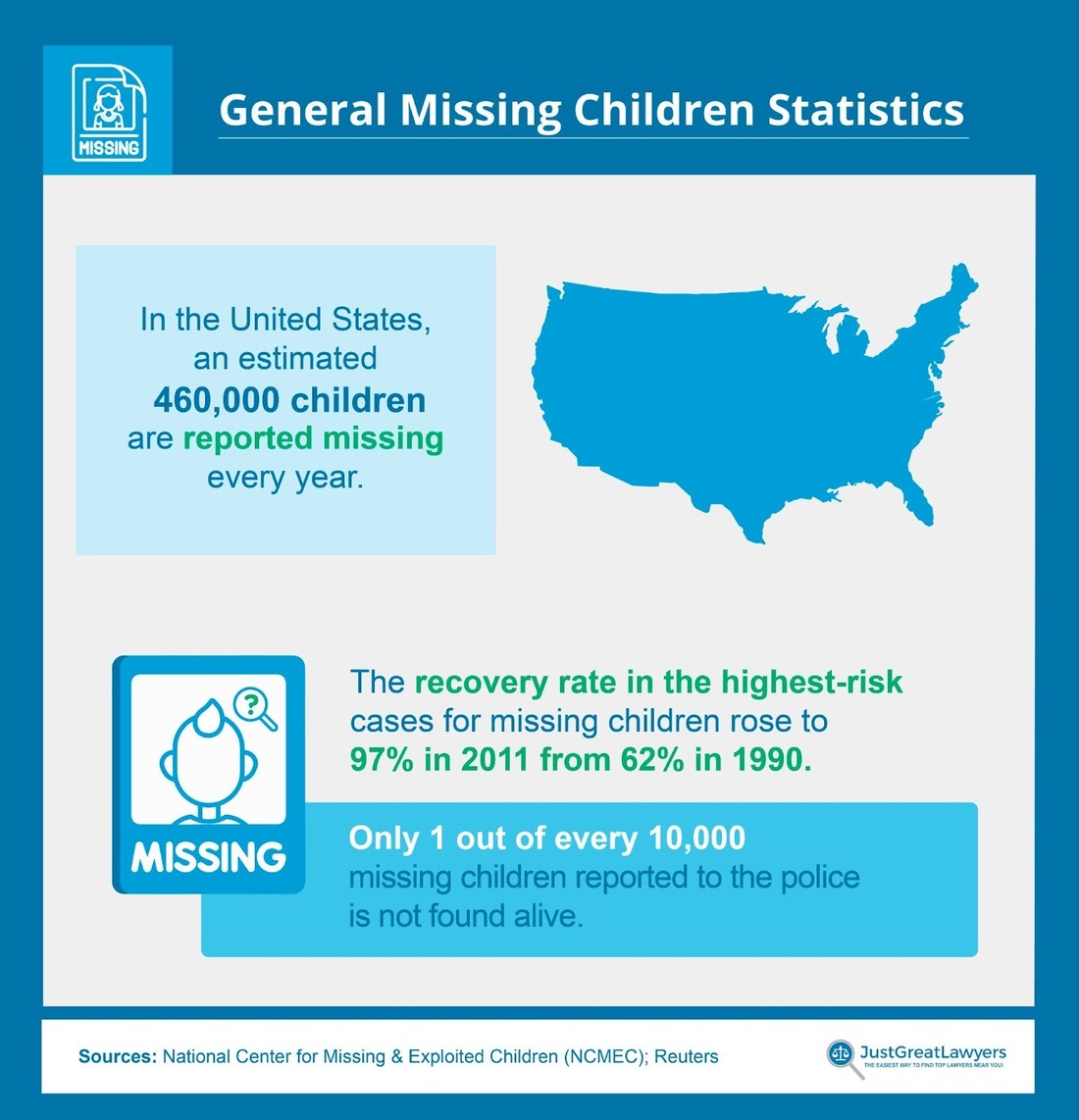
Here are some statistics about missing children in the United States.
In the United States, an estimated 460,000 children are reported missing every year.
In 2019, the total number of missing children entries into the FBI's National Crime Information Center system (NCIC) was 421,394.
In 2020, the National Center for Missing and Exploited Children (NCMEC) helped law enforcement, families, and child welfare with 29,782 cases of missing children.
Only 1 out of every 10,000 missing children reported to the police is the victim of murder.
In 2011, the Federal Bureau of Investigation (FBI) reported that a child goes missing every 40 seconds in the United States.
The recovery rate in highest-risk cases for missing children rose to 97% in 2011 from 62% in 1990. More than 99% of missing children return home alive.
The largest number of minors reported missing in the NCMEC’s 2020 database were between the ages of 12 and 17. This reflects the fact that the vast majority of missing children are runaways, and older children are both more likely and capable to run away.
Per NCMEC's 2020 database, here’s the breakdown of missing children by age.
Children reported missing in 2020 by age:
20,981 children ages 15 to 17
6,099 children ages 12 to 14
1,002 people ages 18 to 20
561 children younger than 2
394 children ages 9 to 11
391 children ages 3 to 5
301 children ages 6 to 8
53 children reported missing were unknown ages
In 2020, the highest number of missing children were aged 15 to 17. The second-highest number of missing children in 2020 were aged 12 to 14.
Children aged 6 to 8 were the group with the least amount of missing children in 2020.
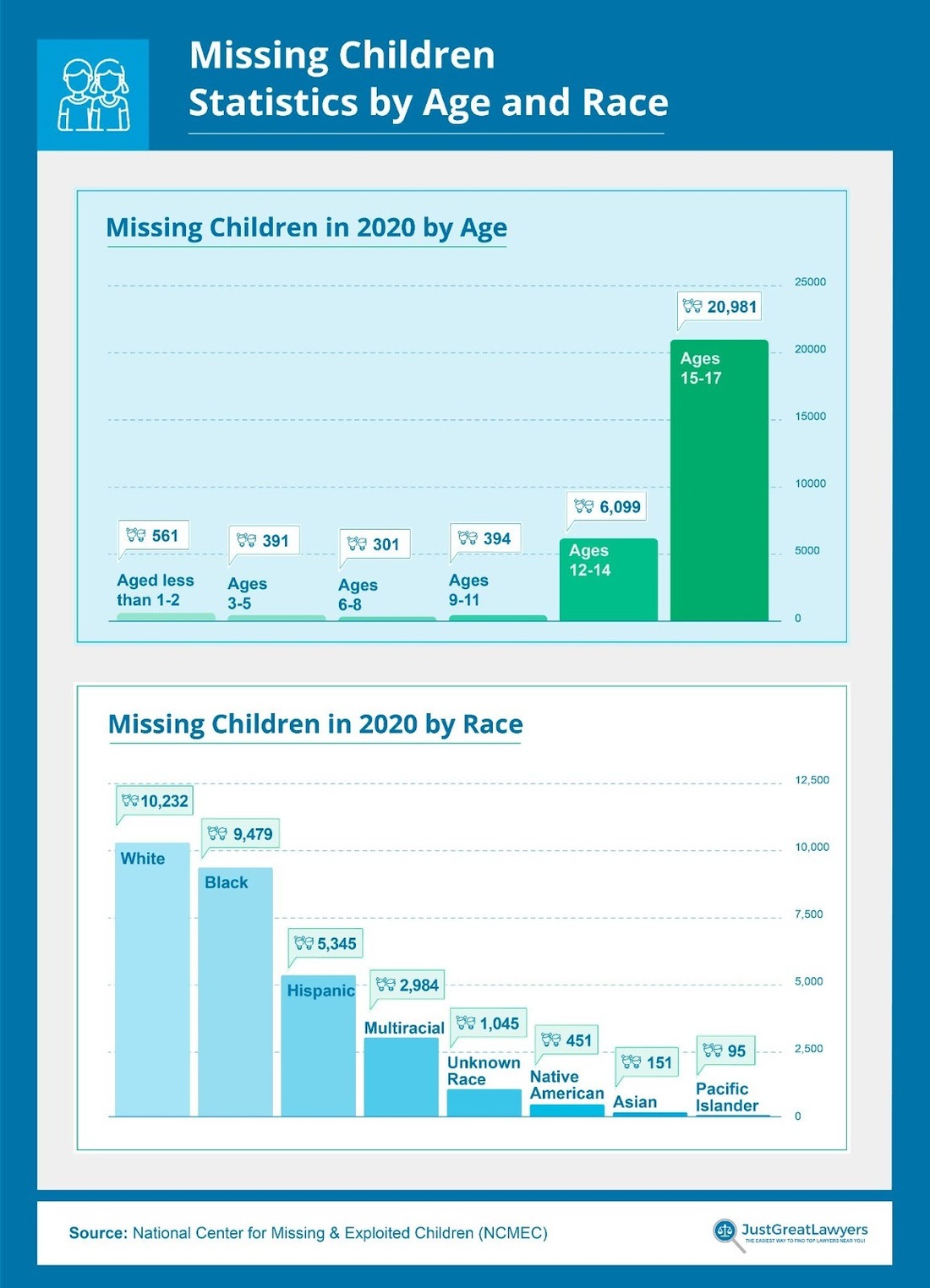
White children are reported missing most frequently. However, black children represent a much larger percentage of those reported missing in relation to their share of the overall population (13.4%) than white children do, with whites making up 76.3% of the population.
Hispanic children account for more than half as many missing cases as white children do, but the Hispanic population overall is just one-quarter the size of the white population.
Per the NCMEC's 2020 database, here's the breakdown of missing children by race.
Children reported missing in 2020 by race:
10,232 white children
9,479 Black children
5,345 Hispanic children
2,984 multiracial children
1,045 children of unknown race
451 Native American children
151 Asian children
95 Pacific Islander children
Comparatively, Black children younger than 1 or 2 years of age were reported missing more often than other races. 215 Black children younger than 1 or 2 years old were reported missing in 2020.
Per the NCMEC's 2020 database of missing children cases, the top five states in the U.S. with the most missing children are as follows:
Texas (3,588)
New York (2,502)
Florida (2,197)
Ohio (2,259)
California (1,828)
Washington (1,585)
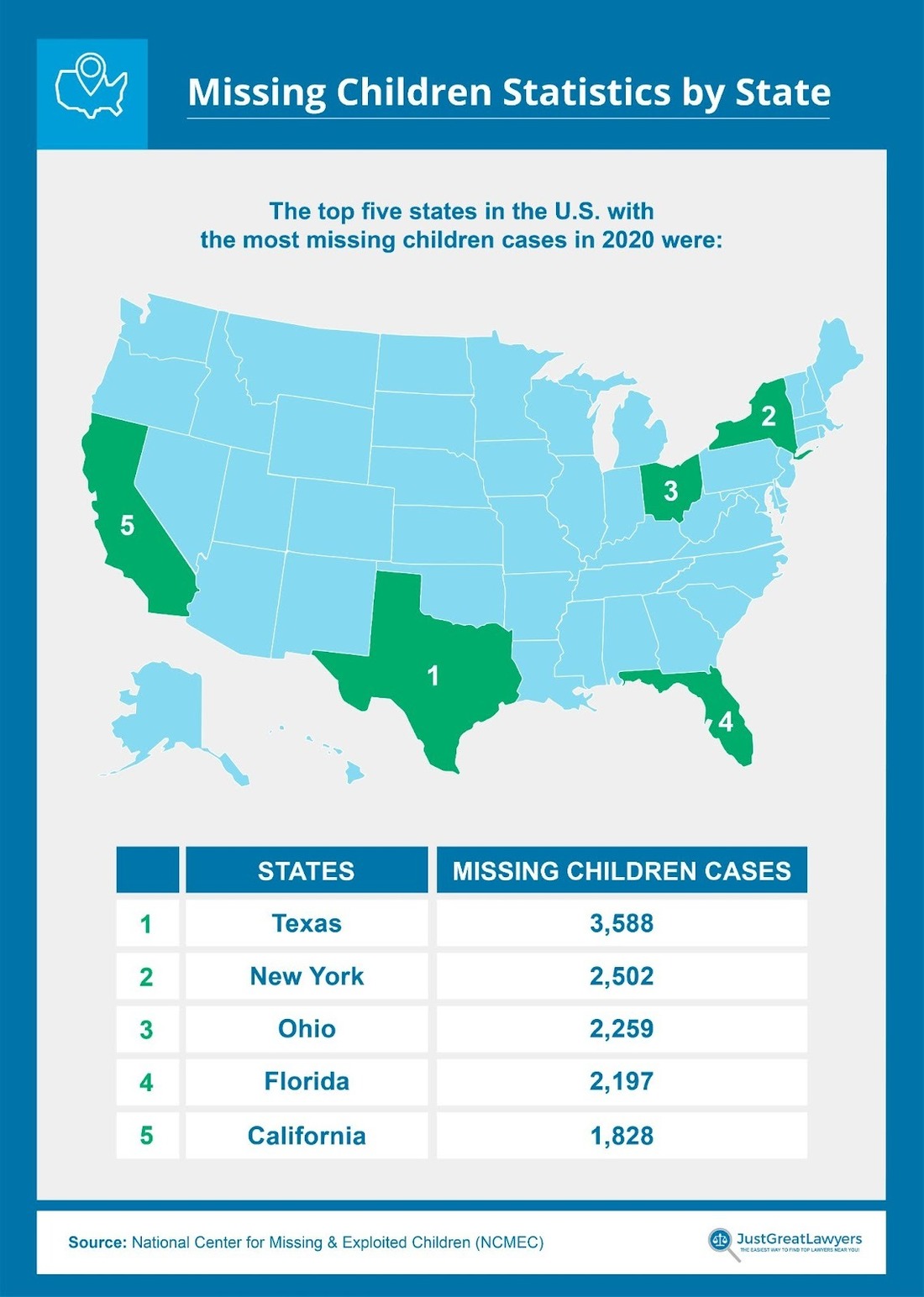
Higher-population states, not surprisingly, tended to have more cases, with the two most populous states — California and Texas — leading the way in the number of active cases for 2020. Active cases refer to the number of reported cases that were investigated during the year’s time.
New Hampshire and Maine, both of which rank among the 10 least populous states, were at the bottom of the missing children’s list, followed closely by Montana, Wyoming, Vermont, and the Dakotas.
California had the highest number of active missing children cases (327) in 2020.
Texas had the second-highest number of active missing children cases (226).
New Hampshire and Maine both had no active missing children cases by the end of 2020.
Montana, North Dakota, South Dakota, Vermont, and Wyoming had just one active case at year’s end.
NOTE: These cases refer to reported cases of missing children in each state; they are not a conclusive list, as not all missing persons get reported. |
The vast majority of children who go missing are found, which correlates with the fact that by far the largest number of missing children fall into one of two categories: runaways and throwaways (children told to leave the house without any alternative shelter being set up), and misunderstandings.
A 2002 study showed that these two reasons together accounted for 84% of all children reported missing.
A 1999 study showed that 1.5 million missing children were either runaways or throwaways.
This compares to 203,900 victims of family abduction and 58,000 kidnappings by strangers.
However, because the vast majority of cases involve runaways/throwaways and misunderstandings, these cases are easier to resolve: No third party is trying to keep the child from returning home, and the child can generally choose to return if and when they want.
In addition, heightened awareness and an increased focus on the problem by agencies such as the FBI, the NCIC, and the NCMEC, along with programs such as AMBER Alerts, have created additional resources to help prevent abductions and child trafficking and help find missing children.
More children still are reported missing in the United States than in many other countries.
For instance, India — a nation with four times the population of the U.S. — had just a little more than one-quarter as many reports (111,569) in 2016 as the U.S. did in 2019. Russia, with 44% as many people as the United States, had just 12% of the number of missing children’s reports (50,000) compared with the U.S. in 2019.
The averages in Russia and India are even less, as shown below in a comparison of several countries, none of which approaches the number of children reported missing in the U.S.
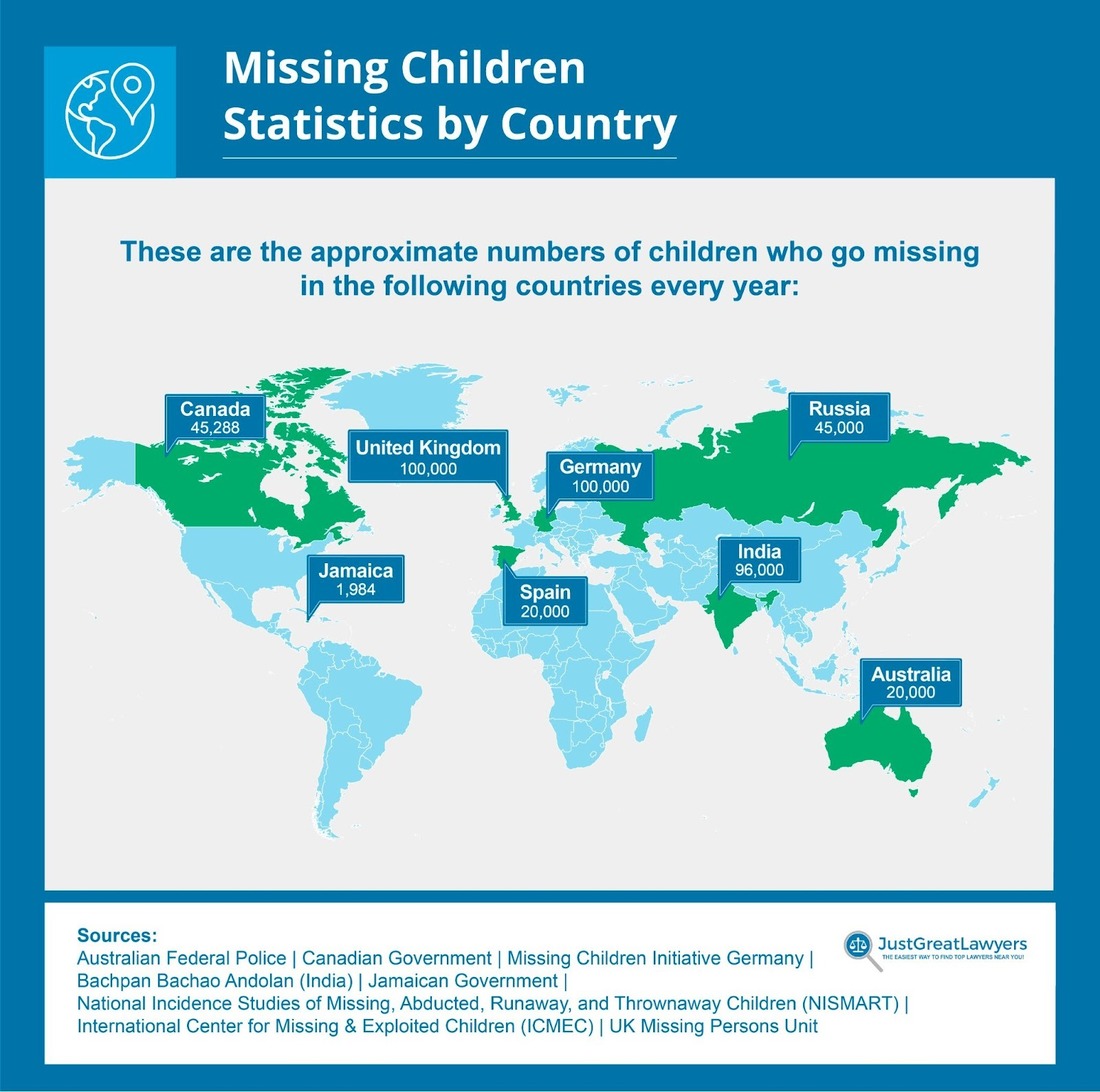
According to the International Centre for Missing and Exploited Children (ICMEC) in conjunction with other international agencies and police, here’s a breakdown of how many children are reported missing each year in other countries.
In Australia, an estimated 20,000 children are reported missing every year.
In Canada, an estimated 45,288 children are reported missing each year.
In Germany, an estimated 100,000 children are reported missing each year.
In India, an estimated 96,000 children go missing each year.
In Jamaica, an estimated 1,984 children were reported missing in 2015.
In Russia, an estimated 45,000 children were reported missing in 2015.
In Spain, an estimated 20,000 children are reported missing every year.
In the United Kingdom, an estimated 112,853 children are reported missing every year.
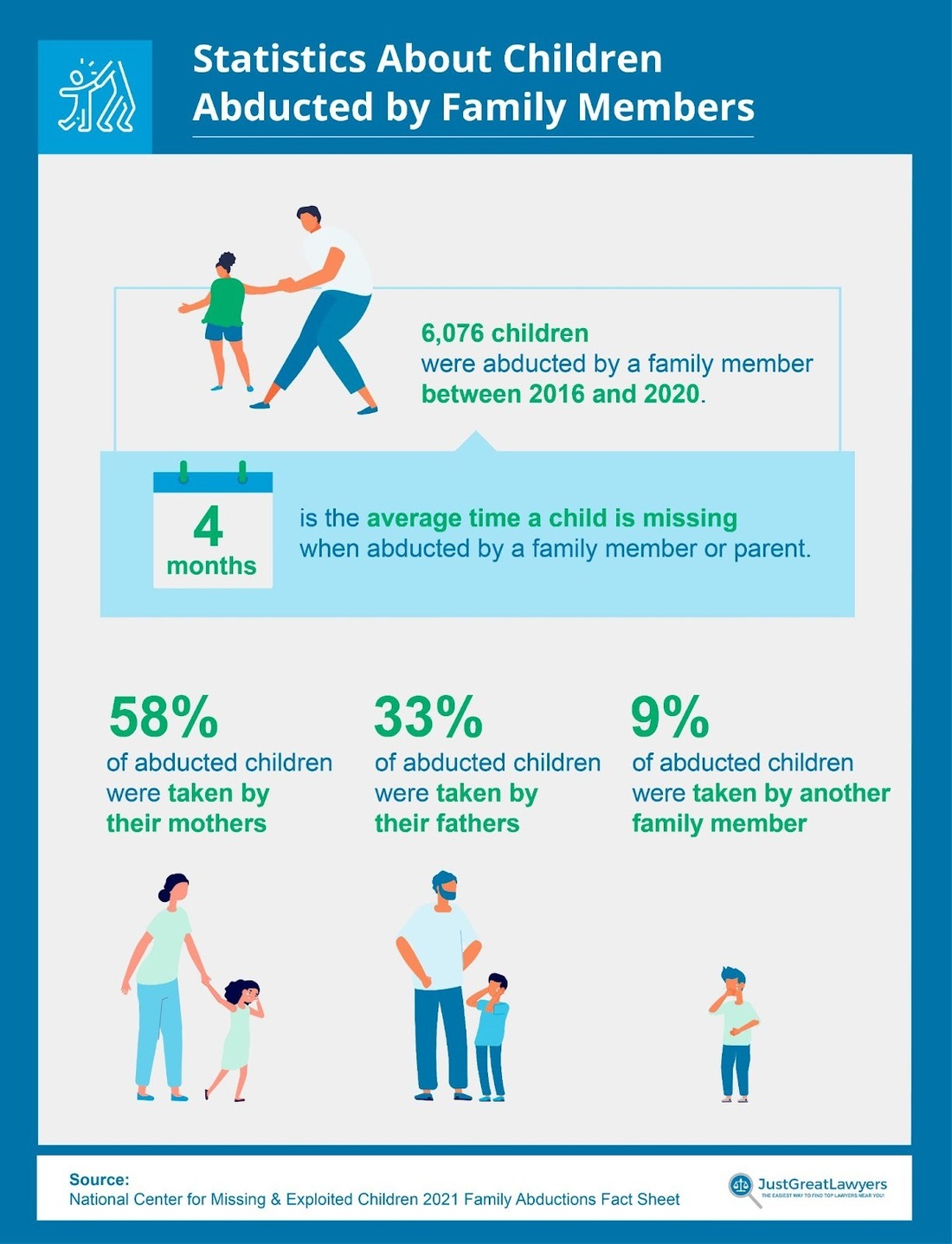
Per the 2021 Family Abductions Fact Sheet by NCMEC, here are recent statistics about child abductions by family and parents (2016-2020):
6,076 children were abducted by a family member between 2016 and 2020. 21 of those children were recovered deceased.
From 2016 to 2020, four months was the average time a child was missing when abducted by a family member or parent.
64% of children who were abducted by a family member or parent were between the ages of 0 and 6.
Summer was the most common time of year for children to be abducted by family members or parents — 30% of cases occurred during this time.
24% of these abducted children were turned in by a family member or friend.
58% of these abducted children were taken by their mothers.
33% of abductors were a child’s father.
9% of abductors were another family member.
Abductions by non-family members are most likely to make the news because they’re the most dangerous.
In contrast to 99% of runaways who return safely, 1 in 5 non-family abduction victims isn’t found alive.
Victims of non-family abductions were overwhelmingly female and nearly half were victims of sexual assault. Here are some additional kidnapping statistics:
On average, fewer than 350 people under the age of 21 have been abducted by strangers in the United States per year since 2010.
Abductions by strangers are the rarest type of cases of missing children.
Of non-family abduction cases reported to the NCMEC, around 20% are not found alive.
At-risk children tend to be at a higher risk for becoming runaways and/or homeless than the general population. This includes minors who are older when they enter foster care, those affected by mental health issues, pregnant teens, and those struggling with substance abuse.
The National Runaway Safeline reports that between 1.6 million and 2.8 million youth run away each year.
In 2017, of the 27,000 missing child cases reported to NCMEC, 91% were for endangered runaways.
Children age 15 when they first enter foster care have the highest risk of running away.
According to Missed Opportunities: Youth Homelessness in America (2019), around one in 10 young adults aged 18 to 25 and at least one in 30 youth ages 13 to 17 experienced unaccompanied homelessness within a 12-month period.
The National Center for Homeless Education found that the number of unaccompanied homeless students increased by 25% between the 2014-2015 and 2016-2017 school years.
AMBER alerts are used to inform the public that a child has been abducted and to seek community members’ help in finding them.
AMBER stands for America’s Missing: Broadcast Emergency Response, but it is also named for Amber Hagerman, a 9-year-old girl kidnapped while riding her bicycle in Arlington, Texas, and later murdered. The AMBER alert system began in the Dallas-Fort Worth-Arlington area as a cooperative effort between police and broadcasters.
Other jurisdictions soon adopted variations on the system. Some adopted different names to honor abducted children in their regions, and different areas created different upper age limits: Some only issued alerts for children younger than 10, others 12, 14, 15, or 16. The Department of Justice (DOJ) has recommended a uniform upper age limit of 17.
Other DOJ recommendations call for a reasonable belief on the part of law enforcement that a child has been abducted; that the child is believed to be in imminent danger of death or serious injury; and that enough identifying information is available about the child, suspect, and suspect’s vehicle to help the public assist in finding the victim.
AMBER Alert data should then be entered into the NCIC system.
As of December 31, 2020, a total of 1,053 children had been recovered as a direct result of AMBER Alert programs.
Missing children and their families can find a variety of different resources to help them during times of crisis. Some organizations work to prevent child kidnappings, others seek to reunite missing children with their families, and still others provide support and resources for the children themselves.
By creating a comprehensive approach to the problem, these organizations together help combat the challenge of missing children and the problems associated with it.
National Center for Missing & Exploited Children (NCMEC): A U.S.-based nonprofit organization that works to find missing children and conducts research to prevent child sexual exploitation and child abductions alongside the U.S. Department of Justice.
The Center for Hope: A nonprofit organization that helps provide support and resources for families of missing children.
The Committee for Missing Children, Inc.: A parent advocacy network that produces and distributes pictures of missing children worldwide to try to reconnect parents with their missing and abducted children.
Texas Equusearch: A nonprofit organization based in Texas that provides local mounted search and rescue efforts for lost and missing persons of all ages.
The problem of missing children isn’t limited to the United States. Child trafficking, while not the most common issue, is one that can put children beyond the reach of local law enforcement search efforts. Fortunately, international organizations have been formed to help find children who are transported across borders. Here are a few of them.
Doe Network: An international, volunteer-run organization focused on finding missing persons, including children, worldwide.
International Centre for Missing & Exploited Children (ICMEC): An international organization that has worked in over 120 countries to locate missing children and empower communities to prevent future tragedies.
Global Missing Children's Center: A branch of ICMEC, the Global Missing Children's Center helps provide resources and information to law enforcement, governments, and NGOs to help find missing children and identify unidentified persons who have been found.
If you’re interested in helping combat the problem of missing children, you can help advocate for children as a volunteer with NCMEC. You can contact the NCMEC to find resources, including publications, an app, and a cyber tipline.
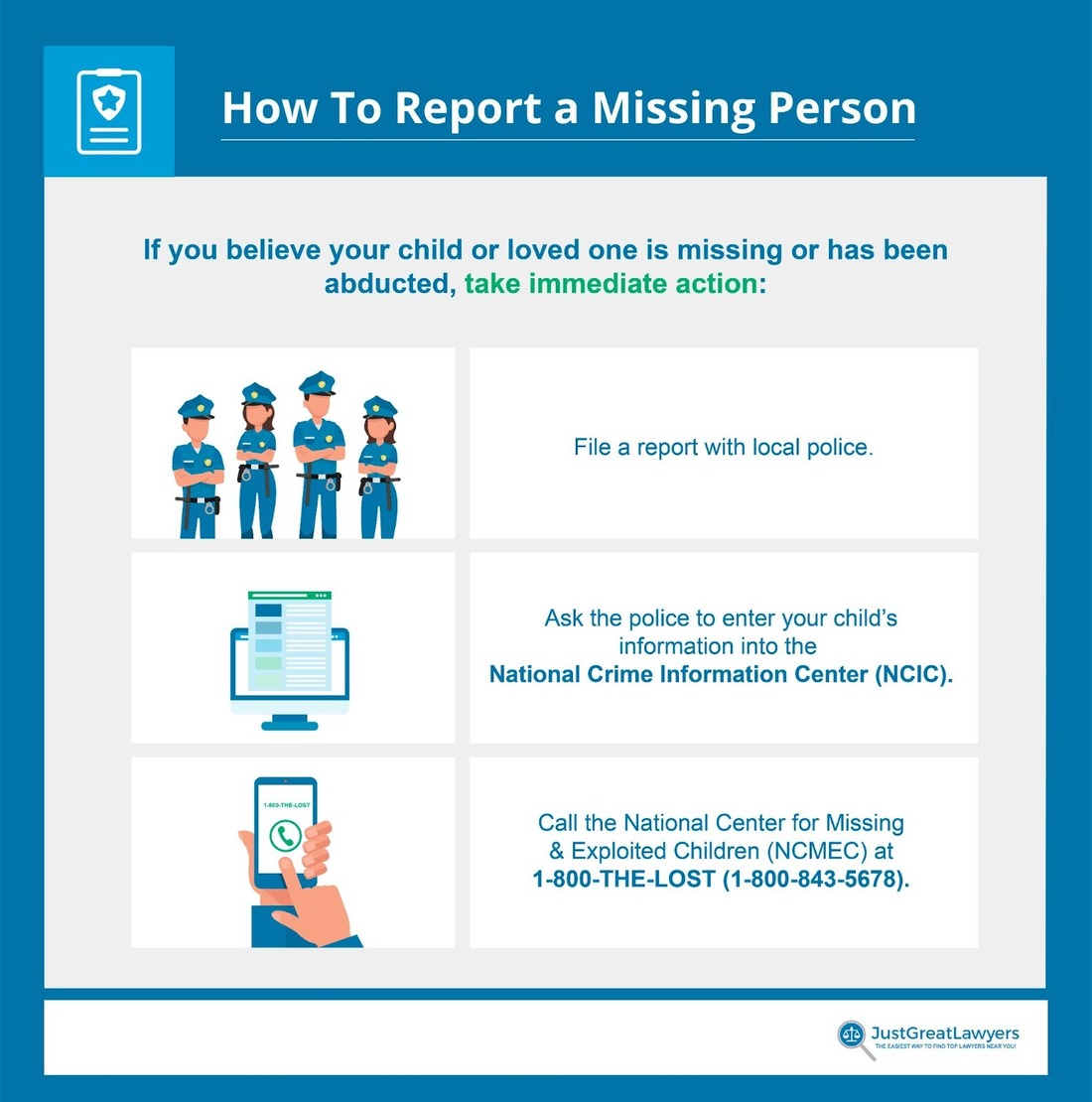
If you believe your child is missing, it’s important to act immediately in case an abduction has occurred. There’s generally a two-hour delay in making an initial report that a child is missing, but the vast majority of abducted children who are killed are dead within three hours after they’re kidnapped.
First, contact law enforcement; then get in touch with NCMEC at 800-843-5678 (800-THE-LOST).
A family lawyer can help you work with law enforcement to help locate your missing child. Many lawyers provide free consultations. Find a lawyer you trust to help bring about the best resolution possible to your missing persons case: reuniting your child with you and the rest of their family.
